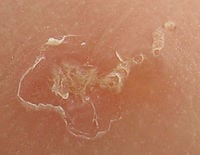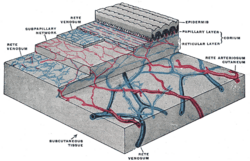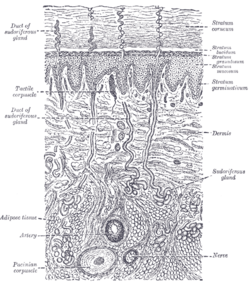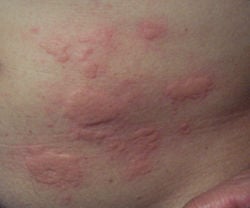Skin
In zootomy and dermatology, skin is an organ of the integumentary system made up of multiple layers of epithelial tissues that guard underlying muscles and organs. As the interface with the surroundings, it plays the most important role in protecting against pathogens. Its other main functions are insulation and temperature regulation, sensation and vitamin D and B synthesis. Skin is considered one of the most important parts of the body.
Skin has pigmentation, or melanin, provided by melanocytes, which absorb some of the potentially dangerous ultraviolet radiation in sunlight. It also contains DNA repair enzymes which help to reverse UV damage, and people who lack the genes for these enzymes suffer high rates of skin cancer. One form predominantly produced by UV light, malignant melanoma, is particularly invasive, causing it to spread quickly, and can often be deadly. Human skin pigmentation varies among populations in a striking manner. This has sometimes led to the classification of people(s) on the basis of skin color.
Mammalian skin often contains hairs, which in sufficient density is called fur. The hair mainly serves to augment the insulation the skin provides, but can also serve as a secondary sexual characteristic or as camouflage. On some animals the skin is very hard and thick, and can be processed to create leather. Reptiles and fish have hard protective scales on their skin for protection, and birds have hard feathers, all made of tough β-keratins. Amphibian skin is not a strong barrier to passage of chemicals and is often subject to osmosis. A frog sitting in an anesthetic solution will quickly go to sleep.
Damaged skin will try to heal by forming scar tissue, often giving rise to discoloration and depigmentation of the skin.
The skin is often known as "the largest organ of the human body". This applies to exterior surface, as it covers the body, appearing to have the largest surface area of all the organs. Moreover, it applies to weight, as it weighs more than any single internal organ, accounting for about 15 percent of body weight. For the average adult human, the skin has a surface area of between 1.5-2.0 square meters, most of it is between 2-3 mm thick. The average square inch of skin holds 650 sweat glands, 20 blood vessels, 60,000 melanocytes, and more than a thousand nerve endings.
The use of natural or synthetic cosmetics to treat the appearance of the face and condition of the skin (such as pore control and black head cleansing) is common among many cultures.
Layers
Skin is composed of three primary layers: the epidermis, which provides waterproofing and serves as a barrier to infection; the dermis, which serves as a location for the appendages of skin; and the hypodermis (subcutaneous adipose layer), which is called the basement membrane.
Epidermis
Epidermis is the outermost layer of the skin. It forms the waterproof, protective wrap over the body's surface and is made up of stratified squamous epithelium with an underlying basal lamina.
The outermost epidermis consists of stratified squamous epithelium with an underlying connective tissue section, or dermis, and a hypodermis, or basement membrane. The epidermis contains no blood vessels, and cells in the deepest layers are nourished by diffusion from blood capillaries extending to the upper layers of the dermis. The main type of cells which make up the epidermis are keratinocytes, with melanocytes and Langerhans cells also present. The epidermis can be further subdivided into the following strata (beginning with the outermost layer): corneum, lucidum(only in feet), granulosum, spinosum, basale. Cells are formed through mitosis at the basale layer. The daughter cells, (see cell division) move up the strata changing shape and composition as they die due to isolation from their blood source. The cytoplasm is released and the protein keratin is inserted. They eventually reach the corneum and slough off (desquamation). This process is called keratinization and takes place within about 30 days. This keratinized layer of skin is responsible for keeping water in the body and keeping other harmful chemicals and pathogens out, making skin a natural barrier to infection.
Components
It contains no blood vessels, and is nourished by diffusion from the dermis. The main type of cells which make up the epidermis are keratinocytes, melanocytes, Langerhans cells and Merkels cells.
Layers
Epidermis is divided into several layers where cells are formed through mitosis at the innermost layers. They move up the strata changing shape and composition as they differentiate and become filled with keratin. They eventually reach the top layer called stratum corneum and become sloughed off, or desquamated. This process is called keratinization and takes place within weeks. The outermost layer of Epidermis consists of 25 to 30 layers of dead cells.
Sublayers
Epidermis is divided into the following 5 sublayers or strata:
- Stratum corneum
- Stratum lucidum
- Stratum granulosum
- Stratum spinosum
- Stratum germinativum (also called "stratum basale")
Mnemonics that are good for remembering the layers of the skin (using "stratum basale" instead of "stratum germinativum"):
- "Corn Lovers Grow Several Bales" (from superficial to deep)
- "Cher Likes Getting Skin Botoxed" (from superficial to deep)
- "Before signing, get legal counsel" (from deep to superficial)
Blood capillaries are found beneath the epidermis, and are linked to an arteriole and a venule. Arterial shunt vessels may bypass the network in ears, the nose and fingertips.
| Dermis | |
|---|---|
| The distribution of the bloodvessels in the skin of the sole of the foot. (Corium - TA alternate term for dermis - is labeled at upper right.) | |
| A diagrammatic sectional view of the skin (magnified). (Dermis labeled at center right.) | |
| Gray's | subject #234 1065 |
| MeSH | Dermis |
| Dorlands/Elsevier | d_11/12289496 |
Dermis
The dermis is the layer of skin beneath the epidermis that consists of connective tissue and cushions the body from stress and strain. The dermis is tightly connected to the epidermis by a basement membrane. It also harbors many nerve endings that provide the sense of touch and heat. It contains the hair follicles, sweat glands, sebaceous glands, apocrine glands and blood vessels. The blood vessels in the dermis provide nourishment and waste removal to its own cells as well as the Stratum basale of the epidermis.
Structure
The dermis is structurally divided into two areas: a superficial area adjacent to the epidermis, called the papillary region, and a deep thicker area known as the reticular region.
Papillary region
The papillary region is composed of loose areolar connective tissue. It is named for its fingerlike projections called papillae, that extend toward the epidermis. The papillae provide the dermis with a "bumpy" surface that interdigitates with the epidermis, strengthening the connection between the two layers of skin.
In the palms, fingers, soles, and toes, the influence of the papillae projecting into the epidermis forms contours in the skin's surface. These are called friction ridges, because they help the hand or foot to grasp by increasing friction. Friction ridges occur in patterns (see fingerprint) that are genetically determined and are therefore unique to the individual, making it possible to use fingerprints or footprints as a means of identification.
Reticular region
The reticular region lies deep in the papillary region and is usually much thicker. It is composed of dense irregular connective tissue, and receives its name from the dense concentration of collagenous, elastic, and reticular fibers that weave throughout it. These protein fibers give the dermis its properties of strength, extensibility, and elasticity.
Located within the reticular region are also the roots of the hair, sebaceous glands, sweat glands, receptors, nails, and blood vessels.
Tattoo ink is injected into the dermis. Stretch marks from pregnancy are also located in the dermis.
The hypodermis is not part of the skin, and lies below the dermis. Its purpose is to attach the skin to underlying bone and muscle as well as supplying it with blood vessels and nerves. It consists of loose connective tissue and elastin. The main cell types are fibroblasts, macrophages and adipocytes (the hypodermis contains 50% of body fat). Fat serves as padding and insulation for the body.
Microorganisms like Staphylococcus epidermidis colonize the skin surface. These microorganisms serve as ecoorgan. The density of skin flora depends on region of the skin. The disinfected skin surface gets recolonized from bacteria residing in the deeper areas of the hair follicle, gut and urogenital openings.
Variability in skin tone
Individuals with ancestors from different parts of the world have highly visible differences in skin pigmentation. Individuals with African ancestry (black people) tend towards darker skin, while those of Northern European descent (white people) have paler skin. Between these extremes are individuals of Asian, South-East Asian, Native American, Middle Eastern, Polynesian and Melanesian descent.
African American skin has more variation in color from one part of the body to another then does the skin of other racial groups. Part of this is the result of the variations in the thickness of the skin or different parts of the body. The thicker the skin the more layers of cell with melanin in them, and the darker the color.[1]
Functions
- Protection: an anatomical barrier between the internal and external environment in bodily defense; Langerhans cells in the skin are part of the adaptive immune system
- Sensation: contains a variety of nerve endings that react to heat, cold, touch, pressure, vibration, and tissue injury; see somatosensory system and touch.
- Heat regulation: the skin contains a blood supply far greater than its requirements which allows precise control of energy loss by radiation, convection and conduction. Dilated blood vessels increase perfusion and heat loss while constricted vessels greatly reduce cutaneous blood flow and conserve heat. Erector pili muscles are significant in animals.
- Control of evaporation: the skin provides a relatively dry and impermeable barrier to fluid loss. Loss of this function contributes to the massive fluid loss in burns.
- Aesthetics and communication: others see our skin and can assess our mood, physical state and attractiveness.
- Storage and synthesis: acts as a storage centre for lipids and water, as well as a means of synthesis of vitamin D and B by action of UV on certain parts of the skin. This synthesis is linked to pigmentation, with darker skin producing more vitamin B than D, and vice versa.
- Excretion: The concentration of urea is 1/130th that of urine. Excretion by sweating is at most a secondary function to temperature regulation.
- Absorption: Oxygen, nitrogen and carbon dioxide can diffuse into the epidermis in small amounts, some animals using their skin for their sole respiration organ. In addition, medicine can be administered through the skin, by ointments or by means of adhesive patch, such as the nicotine patch or iontophoresis. The skin is an important site of transport in many other organisms.
Hygiene
The skin must be regularly cleaned; unless enough care is taken it will become cracked or inflamed. Unclean skin favors the development of pathogenic organisms - the dead cells that continually slough off of the epidermis mix with the secretions of the sweat and sebaceous glands and the dust found on the skin to form a filthy layer on its surface. If not washed away, the slurry of sweat and sebaceous secretions mixed with dirt and dead skin is decomposed by bacterial flora, producing a foul smell. Functions of the skin are disturbed when it is dirty; it becomes more easily damaged, the release of antibacterial compounds decreases and dirty skin is more prone to develop infections. Cosmetics should be used carefully because these may cause allergic reactions. Each season requires suitable clothing in order to facilitate the evaporation of the sweat. Sunlight, water and air play an important role in keeping the skin healthy.
The skin supports its own ecosystems of microorganisms, including yeasts and bacteria, which cannot be removed by any amount of cleaning. Estimates place the number of individual bacteria on the surface of one square inch of human skin at 50 million though this figure varies greatly over the average 20 feet2 of human skin. Oily surfaces, such as the face, may contain over 500 million bacteria per square inch. Despite these vast quantities, all of the bacteria found on the skin's surface would fit into a volume the size of a pea.[2] In general the microorganisms keep one another in check and are part of a healthy skin. When the balance is disturbed there may be an overgrowth and infection, such as when antibiotics kill microbes, resulting in an overgrowth of yeast. The skin is continuous with the inner epithelial lining of the body at the orifices, each of which supports its own complement of microbes.
Aging
- For more details on this topic, see ageing.

As skin ages, it becomes thinner and more easily damaged. Intensifying this effect is the decreasing ability of skin to heal itself. Skin sagging is caused by the fall in elasticity. Skin also receives less blood flow and lower gland activity.
Disease
In medicine, the branch concerned with the skin is called dermatology. The skin is subject to constant attack from without, and so can be afflicted by numerous ailments, such as these:
Tumors:
- Benign tumors of the skin such as Squamous cell papilloma
- Skin cancer
Others:
- Rashes
- Blisters
- Acne
- Keratosis pilaris
- Fungal infections such as athlete's foot
- Microbial infections.
- Calcinosis cutis
- sun burn
- Keloid
Animal skin products
Skins and hides from different animals are used for clothing, bags and other consumer products, usually in the form of leather, but also furs, rawhide, snakeskin and hagfish. Skin can also be used to make products such as gelatin and glue. See also wool.
See also
- Acid mantle
- Anthropodermic bibliopegy
- Callus
- Cosmetics and cosmetic surgery
- Cutaneous structure development
- Dermatology
- Hair
- Skin color
- Hyperpigmentation
- Meissner's corpuscle
- Nails
- Pacinian corpuscle
- Polyphenol antioxidant
- Sweat
ReferencesISBN links support NWE through referral fees
- ↑ Smith, Wilma and Burns, Catherine. (1999) "Managing the hair and skin of African American pediatric patients." Journal of Pediatric Health Care 13(2):72-8.
- ↑ Theodor Rosebury. Life on Man: Secker & Warburg, 1969 ISBN 0-670-42793-4
| Human anatomical features | |
|---|---|
|
HEAD: Forehead – Eye – Ear – Nose – Mouth – Tongue – Teeth – Jaw – Face – Cheek – Chin NECK: Throat – Adam's apple TORSO: Shoulders – Spine – Chest – Breast – Ribcage – Abdomen – Belly button
LIMBS: Arm – Elbow – Forearm – Wrist – Hand – Finger (Thumb - Index finger - Middle finger - Ring finger - Little finger) – Leg – Lap – Thigh – Knee – Calf – Heel – Ankle – Foot – Toe (Hallux) | |
Credits
New World Encyclopedia writers and editors rewrote and completed the Wikipedia article in accordance with New World Encyclopedia standards. This article abides by terms of the Creative Commons CC-by-sa 3.0 License (CC-by-sa), which may be used and disseminated with proper attribution. Credit is due under the terms of this license that can reference both the New World Encyclopedia contributors and the selfless volunteer contributors of the Wikimedia Foundation. To cite this article click here for a list of acceptable citing formats.The history of earlier contributions by wikipedians is accessible to researchers here:
The history of this article since it was imported to New World Encyclopedia:
Note: Some restrictions may apply to use of individual images which are separately licensed.



